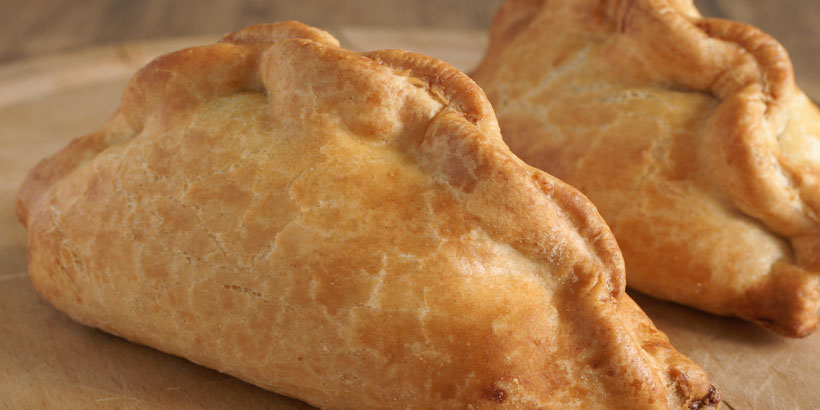The History of…The Cornish Pasty
With our annual pilgrimage to the foodie paradise of Padstow on the North Cornish Coast set for June, my thoughts have been wandering to the joy that is a Cornish Pasty wolfed down in the county of its origin. As you look out over the harbour and the crumbly pastry gives way to a perfectly seasoned mix of piping hot meat, swede, onion and potatoes all seems right with the world. But how did this classic Cornish fayre come about? In this latest addition of our ‘History of…’ series I look at the culinary delight that is the Cornish pasty.
The Cornish pasty is descended from a wider tradition of English meat pies which can be traced back in history to the 13th century, as Chaucer’s Canterbury Tales make reference to them. The Cornish pasty we know and love was a handy portable lunch for families, farmers, fishermen and most famously Cornish tin miners of the 19th century, although archivists have found references to Cornish pasties dating back to 1509. It could even be classed as the first real ‘food to go’ concept with the crust crimped to form a handle, which meant that the miners could hold it with their (arsenic-dust covered!) hands so as not to contaminate the part they ate (although other accounts say they ate it all, as we do today having wrapped them in muslin – we may never know!). High in calories to keep them going in what was a very physically demanding job, the Cornish pasty was as practical as it was delicious. A popular lunch, often pasty making was a daily task with family recipes held dear and passed down from mother to daughter (or on some occasions taken to the grave).
Last year the humble Cornish pasty received special designation from the EU (much like Champagne and Parma Ham does) as a protected regional food. This means that there are strict PGI rules which govern what makes a Cornish pasty and they go something like this…
A genuine Cornish pasty must only contain roughly diced or minced beef, sliced or diced potato, swede (turnip), onion, seasoning to taste (mainly salt & pepper). The ingredients must be uncooked when the pasty is assembled and include 12.5% beef and 25% veg. The pastry must be savoury and can be shortcrust, puff or rough puff and must hold all ingredients through cooking and handling without cracking or breaking. The pasty must be crimped into a D shape, with the crimp towards one side. And finally and possibly most importantly given its name…the pasty has to be produced in Cornwall itself.
And they are big business, according to the Cornish Pasty Association 120 million Cornish pasties are produced each year – and that’s just the classic Cornish pasty (not the Thai Green Curry ones or the Korean Chicken ones!). This equates to £300m worth of trade for the Cornish economy, which is about 20% of the total turnover of Cornwall’s food and drink industry and means that of every £1 spent on the food and drink sector in the Duchy, 20p goes on pasties, with at least 2,000 people working in Cornish Pasty production. Personally, as well as the classic, I am partial to a steak & stilton or a cheese & potato pasty and will be sure to keep the sales figures up when I’m in town. In fact as pretty much every bakers boasts an award winning Cornish pasty of some description there is always an excuse to try another one. My Padstow favourites include: The Chough Bakery (on the harbour front) and The Cornish Bakery (on Market Place), but do Tweet us @JellybeanAgency if you have any recommendations.
Other fun facts about pasties
– courtesy of the Cornish Pasty Association (who knew!)…
- The ‘oggy, oggy, oggy’ chant is said to have originated from pasty sellers or tin miners’ wives announcing the arrival of their freshly baked wares. The traditional acknowledgment was ‘oi, oi, oi’.
- A skilled crimper will make 3 or 4 per minute but up to 7 has been known.
- If a pasty is crimped by a left-hander it is called a cock pasty, while right-handed crimpers make hen pasties.
- Crib and croust are Cornish words for a snack or a bite to eat – traditionally, and still today, the pasty is the favourite choice for crib or croust.
- The world’s largest Cornish pasty was made in August 2010, measuring 4.6 metres (15 ft) and weighing 860 kilograms (1,900 lb). It was created by “Proper Cornish” bakers, using 364 lb (165kg) of beef, 180 lb (82 kg) of swede, 100 lb (45 kg) of potatoes and 75 lb (34 kg) of onions.
If you fancy making your own here’s how, but remember unless you live in Cornwall it won’t be the real thing, so best get yourself down to Cornwall and keep this thriving industry going – well, it’s a tough job but someone has to do it!
Jellybean Creative is a leading foodservice agency. We help top brands with foodservice pr, foodservice marketing, foodservice digital and design. If you feel we could help you with your marcomms, strategy, public relations, creative or digital then drop the leading foodservice agency a line today.

